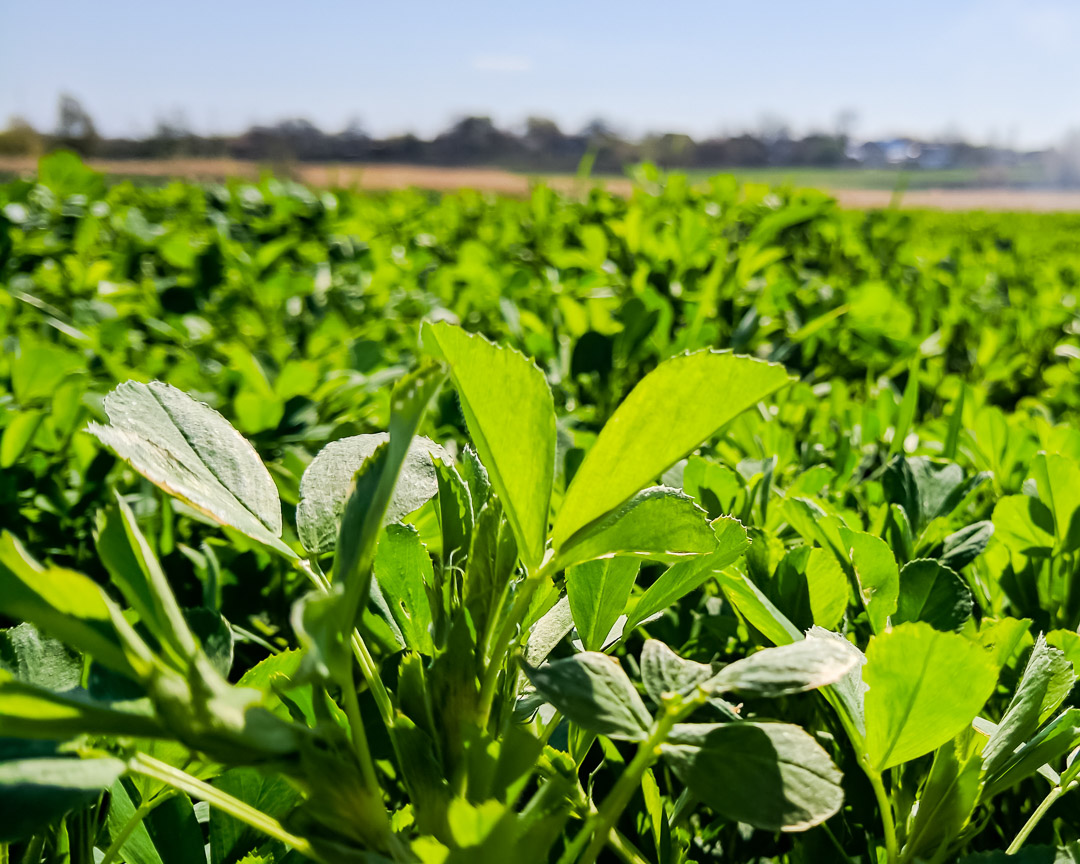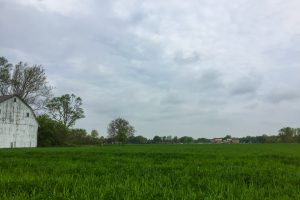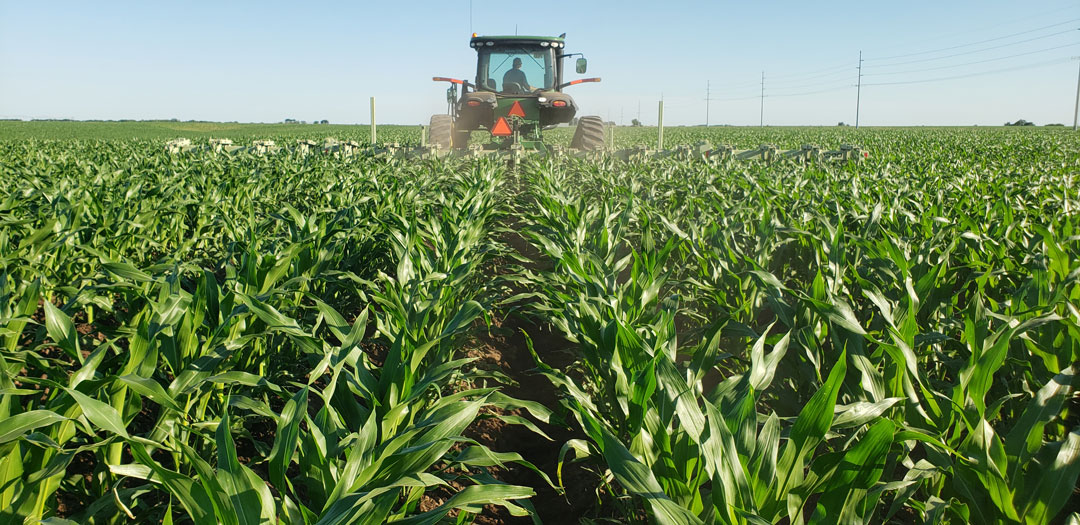- Published On: December 15, 2020
- Author: AgriSecure
We always stress the importance of a diverse crop rotation to achieve long-term organic success. But what if market opportunities for organic crops in your area are limited? How can you diversify your rotation with just a few cash crops?
Answer: Cover crops.
Even though you don’t sell them like cash crops, they can still provide tremendous value to organic farms.
Brandon VanMiddendorp, Regional Sales Manager for La Crosse Seed, shared his insights on why you should use cover crops and how to succeed with them on your organic operation.
-
Soil First 120 Cover Crop Mix (Photo courtesy of La Crosse Seed
-
Soil First 125 Cover Crop Mix (Photo courtesy of La Crosse Seed)
Top reasons organic farms should use cover crops
In addition to diversifying your rotation, cover crops can provide a variety of benefits.
One of the biggest for organic farms is weed suppression.
Some species like cereal rye have allelopathic effects on weeds, in addition to producing enough biomass to suppress weed growth. That biomass also protects the soil from erosion when the ground is typically bare and susceptible to wind, rain, and other elements.
Cover crops are also critical to organic fertility programs. Legumes can supply the soil nitrogen through atmospheric fixation, while other species scavenge and sequester nutrients already in the soil.
For example, your cash crop may not have used all of the nutrients from your manure application. A cover crop can absorb that fertility and eventually rerelease the nutrients after being incorporated back into the soil.
And cover crops do wonders for improving soil health. They add organic matter and their roots help break up compaction. As a result, you’ll see improved soil structure and water-holding capacity. “So when we do get our rains, we’re absorbing that moisture versus having runoff,” Brandon says.
Additionally, they provide habitat and food for beneficial insects. According to the Organic Trade Association, 75% of all crops grown for human consumption rely on pollinators, predominantly bees, for a successful harvest. Certain flowering cover crops help foster the food and habitat they need.
How to select cover crop species
We’ve covered why you should use cover crops. Now let’s discuss how to get started using them.
The first step is selecting a species — or multiple species, known as cover crop mixes.
It starts with identifying which benefit you most want, Brandon says. The next step is selecting the species that will best achieve your goals. So, if your primary focus is fixing nitrogen, a legume would be a good option. On the other hand, a small grain like winter rye will be better for reducing erosion.
But timing is a crucial factor. It doesn’t make sense to use an annual species if you’re seeding in late October or early November because they won’t get much growth, Brandon says. If you plant after a small grain harvest in July, though, you’ll have a much bigger window of opportunity to use species like radishes and turnips.
“Some legumes take a little longer to get established. As a result, we can see various benefits depending on the time window,” he explains. “Planting a little later in the season, after corn comes off, means we don’t have a lot of time and may not be able to gain the advantages off of them.”
Geography naturally plays a role here. The farther south you are, the more opportunity you have to use annual species and legumes later in the season.
Timing and geography also determine whether you can use a mix versus a single species. The longer the establishment window, the more opportunity for using a mix. But Brandon notes, “It’s better to use one species than to not use a cover crop at all.”
Troubleshooting for cover crop challenges
Figuring out that window of opportunity is one of the biggest challenges Brandon sees farmers face with cover cropping. The weather can disrupt both the establishment and termination of cover crops. “If it’s a really dry year, we may not get any growth off of some of these cover crops if it’s late summer, early fall.”
But too much rain in the spring could be a problem for any cover crops that don’t winterkill. If you can’t get out to till under or roller crimp your cover crop because it’s too wet, it’ll continue to grow and hit maturity. That’s because it gets taller and lankier and produces a ton of biomass, so a plan needs to be in place to manage fertility and planting accordingly,” Brandon says.
You should also look out for pests. Brandon points out that cover crop pests won’t be an issue every year, but it makes sense to be watching for them. Like the weather, you need to pay attention to pests and be prepared to make changes.
What about the cost?
Another factor you have to plan for is the cost. One way to lessen the impact of cover crops on your budget is to look for cost-share programs.
Brandon says there aren’t many nationwide programs currently available, so your best bet is to look for local opportunities. Your county’s NRCS office is a good place to start, but also consider local organizations and your specific watershed. Many watersheds have their own cost-share programs for cover cropping to reduce runoff and prevent nutrients from entering waterways.
-
Soil First 101 Cover Starter Mix (Photo courtesy of La Crosse Seed)
-
Soil First 140 Multi-Purpose Mix (Photo courtesy of La Crosse Seed)
Forget the name and think of them as cash crops
So you know what goals you want to achieve. You’ve selected a species or two you’d like to grow, and you understand why. You’ve developed a plan for when you’ll seed and terminate them and how you’ll make adjustments based on the weather and other factors.
Sound familiar?
It should. Because the key to succeeding with cover crops is to treat them like cash crops.
“There are a lot of variables that come into play with cover crops,” Brandon says. “It’s something you need to be paying attention to. Not just planting it and leaving it and thinking everything is going to be just fine.”
There’s no cookie-cutter approach to the practice, he adds. You should develop a program that’s unique to your environment and needs. Know your timing, your area, and how each species works. It’s important to take the approach of finding out what’s best for your farm.
One of the best ways to do that is to learn from others. Brandon suggests seeking out “cover crop adopters” so you can learn from their wins and mistakes. Companies like La Crosse Seed can also be a good place to start. In addition, there are individual farmers, soil health coalitions, and other entities that can be fantastic resources.
AgriSecure can help
But if you’re looking for more tailored advice and support, whether it’s choosing a species that fits your organic rotation to managing the cover crop, AgriSecure and La Crosse Seed are here to help. Contact us to learn how cover crops can work in your organic farm today.
Related Articles
-
Autonomous Farm Equipment Solves Organic Labor and Time Challenges
Ask an organic farmer about their biggest challenges and labor and time crunches are likely to be at the top. But autonomous farm equipment may soon be an option to help solve those issues. And help growers be more efficient in their operations, too. That’s what Craig Rupp, founder and CEO of Sabanto, has seen […]
-
Sustainable Success with Organic Row Crops
Zero tillage. Continuous cover. Rotational grazing. Several farming practices are regenerative in nature. But when it comes to the economics of sustainable success in agriculture, organics remains one of the strongest. Premiums for organic corn and soybeans have more than doubled their conventional counterparts’ prices over the last decade. This is hanks to high consumer […]
-
Know Your Numbers to Push Crop Profitability
Yield is often the top priority in farming. The truth, though, is that the highest yields will not necessarily result in the highest ROI. And this is especially the case for organic production. We know good execution results in the best yields, but the best way to maximize your crop profitability is to know your […]
-
Organic Crop Plans: Don’t Farm Without Them
Don’t make the one mistake common to all failed organic operations.That is, farming without a detailed and pressure tested crop plan. Let’s be honest. It wasn’t so long ago that organic corn was selling for $12/bushel. Even if farmers made bad decisions, high prices hid their errors and oversights. Markets change, though, and we can […]
-
6 Ways to Protect Organic Profits in Uncertain Times
Economic uncertainty hits all sectors of the agriculture industry, including organics. The good news? It’s possible to safeguard your organic profits. For a start, it’s even more important for organic farmers to focus on executing their operations really well. The better the execution, the better you can weather the market conditions and remain profitable. Here […]
Get in the know
Our newsletter, it’s a quick read. You’ll get industry news plus all the latest organic insights. Who doesn’t want that?









